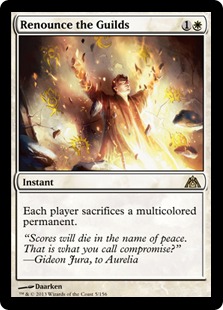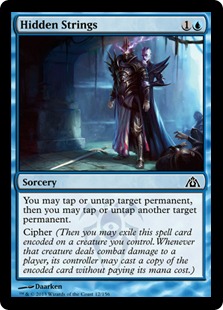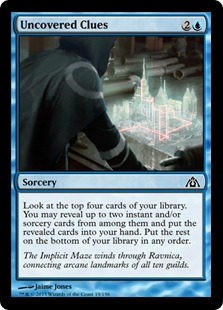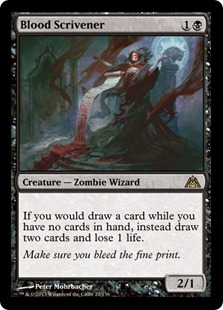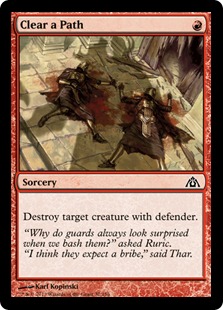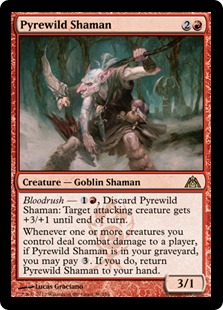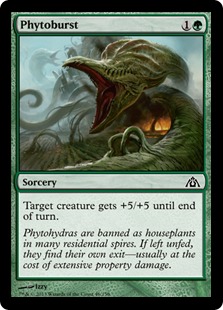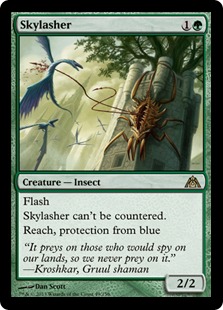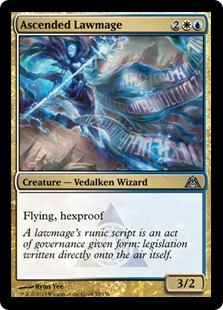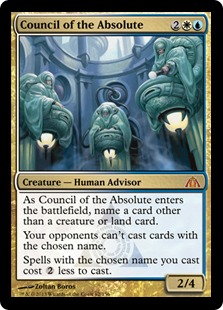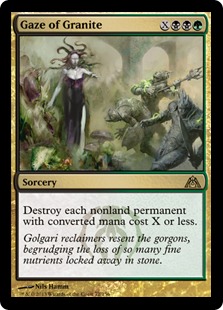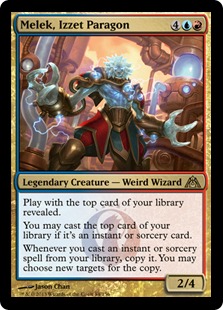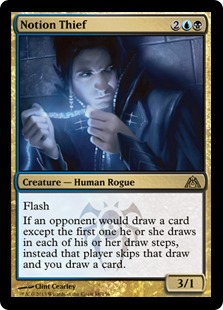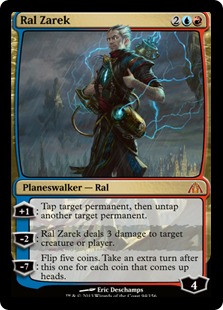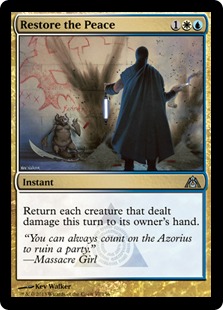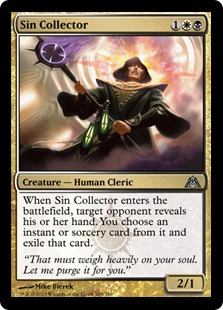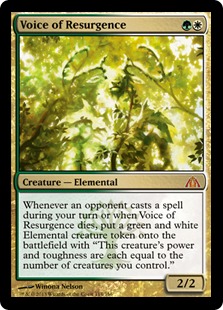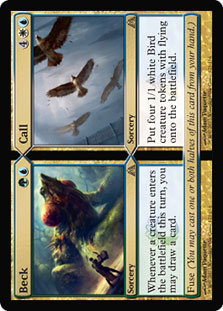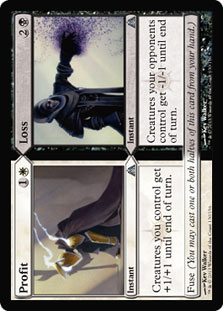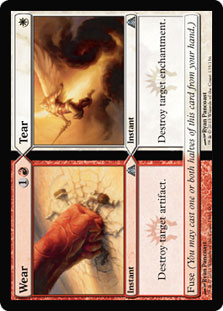Hello everybody and welcome to my traditional brewing article for when a new set comes out. I’d like to do things a little differently today from what I usually do. The reason for this is two-fold. Number one, there aren’t that many sweet cards for me to brew with in this set. Simply put, most of Dragon’s Maze seems to be rather straightforward good cards or cards with rather obvious uses, and those that aren’t are usually overcosted for Legacy use. Don’t worry, though, you’ll still see a decklist or two below for the cards I actually found inspiring, and there will be a large section with short comments on cards I have something to say about.
The second reason is that I’d like to take some time to comment on the design of the set in general, which limits the amount of space I can dedicate to decklists. Let’s get the latter part out of the way first since I’m pretty much a bad news first guy. So get ready for some complaining before we get to all the fun stuff the set delivers. If you prefer getting the good news first, just ctrl+f for "The Good News" and come back here once you’re done reading that part. Let’s get to it, then.
The Bad News
I generally don’t like badmouthing Wizards, and as much as some of the cards they’ve designed have pushed the boundaries in directions that I don’t think are healthy for the game, I think they’ve been doing an awesome job as far as design in general is concerned. Sure, hexproof, Delver, and a particular Demon are really stupid cards, but overall the latest sets were quite awesome.
The cards were sometimes nostalgic, sometimes innovative, and often pushed boundaries or filled holes in the fabric of the game. Even Gatecrash, probably the least exciting set in a while, mainly felt as weak as it did because of how awesome Return to Ravnica was. They can’t all be on that level, especially not for us Eternal players.
Dragon’s Maze, though, I’m quite disappointed with from a design perspective. While I think there are some things done well within the set—it doesn’t introduce any cards that look like they might be truly bad for the game, and there are a number of sweet cards I can’t wait to try out in different archetypes—it’s lacking in two very important areas.
First, there are very few brew-friendly cards that actually excite the Johnny in me. The only card that does something weird enough to really inspire convoluted plans that you love to have come together is Possibility Storm[/author]“][author name="Possibility Storm"]Possibility Storm[/author].
Note that I don’t mean that there aren’t any cards to build around. Maybe saying there aren’t any brew-friendly cards isn’t exactly the right way to put it. There are a number of things to build around and to try to make good. Rather, the execution is so blatantly obvious that it takes a lot of the fun out of the process of exploration.
In short, the build-around-me cards in this set largely feel like Maze’s End’s strapped-on win the game condition does: "play all the Gates to do something cool, duh!" Being hit over the head with it is not the most exciting way to discover what a new set can do.
The Johnny in me having gotten his spot on the soapbox now, here’s the actual biggest issue I have with Dragon’s Maze: the design seems uninspired and conventional, especially for a third set. What do I mean by that?
Well, take a look at Time Spiral, a set designed to recapture the nostalgia of older players (like me). You’d expect a lot of cards that resemble what has come before, yet they managed to make it fresh and entertaining enough for me to still have a sweet spot for it in my heart. Dragon’s Maze, on the other hand, feels like a badly designed nostalgia set—essentially what Time Spiral could have turned out to be if they’d really messed it up.
A lot of the cards in the set—and I haven’t counted, but it feels like it’s most of them that aren’t obvious Limited tools—seem to have been created by a templated process. As a result, the cards feel extremely derivative. The template? Take old card or mechanic A, mix it with old card or mechanic B or an RTR block mechanic, and voila—innovative design! Some examples to illustrate:
Maze’s End: Take Thawing Glaciers, adjust the numbers, make it play with the Gate mechanic.
Render Silent: Counterspell plus Silence.
Progenitor Mimic: Clone plus Followed Footsteps.
Plasm Capture: Reprint Mana Drain, adjust casting cost to make it not broken.
Bred for the Hunt: Take Coastal Piracy, make it work for evolve.
Dragon Shift: Day of the Dragon, make it an overload card.
Gruul War-Chant: Orcish Oriflamme + Goblin War Drums.
Legion’s Initiative: Planar Guide + Crusade, shake it up a little to make it feel multicolored.
Possibility Storm[/author]“][author name="Possibility Storm"]Possibility Storm[/author]: Even the sweetest brew-with-me card follows the pattern—take Eye of the Storm, add cascade, stir, and you’re done.
Morgue Burst: Vengeful Rebirth, make it worse to make it black.
I could continue doing this for quite a while—check for yourself if you don’t believe me—but I don’t think it really helps anyone if I list a ton of old cards and the result of mashing them up here.
Now, don’t get me wrong, this type of design is a totally fine and serviceable tool. Sphinx’s Revelation and Rakdos’s Return (Braingeyser plus Stream of Life and Mind Shatter plus Blaze, respectively) are perfectly fine cards, and so are a number of Dragon’s Maze’s results. Picking up old ideas and giving them a few new twists or mixing and matching them is an important and powerful way to keep the game growing and to explore the hidden potential of past ideas.
When the whole set with few exceptions feels like it’s been created by writing a script that meshes old cards together, though, we have a problem. It feels uninspired, tired, uncreative, and, frankly, boring. And that’s why I think design-wise that Dragon’s Maze is the biggest failure MTG has seen in years.
In short: Wizards, get your game together. You’ve been doing incredible things with the game for a long time and have taken it to a popularity that nobody could have imagined in the Nineties. Please don’t slack off now and squander it by becoming lazy!
The Good News
With that rant/observation (choose whichever you find appropriate) about the design of Dragon’s Maze out of the way, let’s not forget that even an uninspired-looking design process can still deliver a ton of sweet new cards to play with.
As far as Legacy is concerned, the pickings are similar to Gatecrash—relatively slim. That in itself isn’t a bad thing. We’ve had a sweet evolving format for years with only a few cards per set, and only recently, from New Phyrexia onward, have we been spoiled with multiple format-shaking cards making it to print each and every set.
I’m going to go over some Dragon’s Maze cards that caught my eye, be it because I think they fill a particular role in some archetype, because they inspire me to actually put something totally new together, or simply because they invite a snarky comment too much to resist. Here they are in no particular order:
Renounce the Guilds: While this clearly isn’t an all-star, it kills Progenitus if it ever becomes a thing again.
Hidden Strings: Now here’s a card I scoured the arcane archives for only to find it didn’t exist up until now. When I built the Past in Flames powered High Tide list I wrote about here, I was looking for an instant or sorcery untap effect for two mana to make Intuition plus six mana lethal even against creature-free boards or opposing removal, but I came up empty. While this is only going to be a one-of, I fully expect it to make the deck quite a bit better than it has been so far.
Aetherling: I so want this to be playable—Morphling was sweet back in the day—but I realize what six mana actually means.
Uncovered Clues: An interesting draw spell for sure, this might be good if it was instant speed to give High Tide more options. As is, though, I don’t see this turning up in Legacy—and there are few people more interested in jamming instants and sorceries than I am. This might have been a good tool for Modern Storm if that was still a deck.
Blood Scrivener: Now here’s something with potential. For a deck that can rapidly empty out its hand and keep it that way, this becomes a Dark Confidant that probably deals you less damage in the long run. The most obvious application is in something like Burn splashing black—a deck that has already been played in Modern—for both Confidant and this guy to make sure you don’t run out of ammo to throw at your opponent’s head.
More importantly, though, it might provide the incentive to play the one archetype that has fallen off the face of the earth in Legacy during the last year or two: fast aggro.
Here is what I’m going to give a whirl, although I’m quite sure I personally won’t be bringing it to a tournament any time soon—just not my style.
Creatures (29)
- 2 Grim Lavamancer
- 4 Dark Confidant
- 4 Tarmogoyf
- 4 Goblin Guide
- 4 Gravecrawler
- 3 Geralf's Messenger
- 4 Deathrite Shaman
- 4 Blood Scrivener
Lands (19)
Spells (12)

This kind of list has a lot going for it. It has disruption, a fast clock, a low curve, and card advantage potential unheard of in an aggressive deck (other than Goblins, which is a lot less aggressive than people think).
It also gets to run a very low land count but has sufficient mana thanks to Deathrite Shaman as well as a ton of creature-based reach between Geralf’s Messenger, Grim Lavamancer, and Mr. Deathrite himself while still managing to have room for some synergistic disruption in the form of Cabal Therapy. Guess what—Blood Scrivener also happens to be a Zombie, so it enables some interesting Gravecrawler shenanigans in combination with Cabal Therapy and Geralf’s Messenger.
Is this good enough? I don’t know yet, but if you like getting your opponent dead fast, it’s something you should definitely try out.
Clear a Path: I get that they’re trying to tone down spells, but now even Tunnel is too good for modern Magic? Oh, how the mighty have fallen.
Possibility Storm[/author]“][author name="Possibility Storm"]Possibility Storm[/author]: Finally, a real card to brew with, but the best I’ve come up with so far is this plus noncreature morphs (Zoetic Cavern, Lumithread Field) to "cascade" into a hard cast Emrakul, the Aeons Torn. Sadly, that’s obviously so much worse than Sneak Attack, Hive Mind, or Dream Halls that I don’t feel it’s even worth exploring in Legacy. It might be a thing in Modern though. Who knows?
Pyrewild Shaman: I think this could be solid in Goblins (thanks to Max Galensa for pointing this one out to me!), especially if you decide to go back to running the more aggressive Warren Instigator version.
An eight-power double striker is no joke, but even if this only serves to successfully push Goblin Lackey through a Deathrite Shaman or Stoneforge Mystic, having a tutorable recurring pump spell might do wonders in Goblins by giving the small threats some longevity.
[Editor’s Note: Hmmm…those cards have been a problem for me over the past six months…]
Phytoburst: Being sorcery speed is rather clunky for a pump spell, but the fact that this combines with Invigorate to do the full ten of off only two cards makes it a definite possibility in Infect Stompy.
Skylasher: So I guess R&D didn’t get the memo that Delver of Secrets stopped being a problem in Standard when all the good cheap spells rotated? The latest of the Great Sable Stag style "solutions" to unhealthy Standard metagames isn’t all that impressive but might serve its intended purpose of surprising Delvers and Geist of Saint Trafts in larger formats just as well. Scryb Ranger is seeing play, after all, and this wins the fight instead of just holding down the fort.
Ascended Lawmage: If I ever got to play Caw Cartel again, I’d actually consider using one or two of these as my inevitable win condition. Untargetable flyers are hard to come by, and this one is just cheap enough to make it an option. A very solid way of pressuring Jace, the Mind Sculptor if nothing else.
Council of the Absolute: While this is irrelevant in Legacy due to its four mana price tag, I can’t help but imagine how frustrating/game breaking this is going to be in Standard Sphinx’s Revelation mirrors as long as its controller remembers to not run it into an Azorius Charm.
Gaze of Granite: This might be a tool for Scapeshift Nic Fit in the Wish board. The price tag is ridiculously high, but you get to Burning Wish for a Pernicious Deed now—one that takes Jace, the Mind Sculptor with it to boot.
Melek, Izzet Paragon: Even though I doubt its playability, Melek is clearly my favorite card in the set so far. For those who don’t know, the blue Necro aka Future Sight has been one of my favorite cards ever since I built The Shining for Vintage in the early 2000’s.
Sadly, this is much easier to remove and bricks more often than Future Sight does given that you can only play instants and sorceries off the top. With all of them doubling up, though, I doubt you’ll lose many games in which you untap with it. The combination of a six mana price tag and being vulnerable to creature removal probably make that untapping thing into a pipe dream in Legacy, as sad as that is, and I really don’t feel qualified to brew a Standard deck at the moment.
Notion Thief: My pick for Legacy sleeper card of the set. The best-case scenario is so utterly absurd—turn 4 Jace, Brainstorm? Sure, let me draw three, you put two back on top, and on my turn I use Notion Thief to kill your Jace!—and even the utility of preventing the opponent from cantripping at all is nothing to sneeze at. In addition to all that goodness in control mirrors, dropping this of off Show and Tell also neuters Griselbrand into "just" a 7/7 lifelinker, which, ironically enough, is quite a reasonable thing to deal with in Legacy on turn 3.
Sure, four mana is a lot, but both Venser, Shaper Savant and Vendilion Clique are being played in control decks. This has a lot more raw power than either of them under the right circumstances, even if it is a lot less flexible.
Plasm Capture: Another card I don’t expect to see in Legacy because four mana is just too much for a counterspell in this format, but Standard players who have tuned in, look out. You might think this looks innocuous enough, but you probably haven’t played with Mana Drain before, especially in a format full of fives and sixes.
If something like Cryptic Command could see Standard play, this probably will too, and the blowouts will be epic. Countering an opposing Thragtusk makes it possible to cast roughly anything, up to and including Omniscience or Nicol Bolas, Planeswalker on your fifth turn!
Ral Zarek: Ral fails the Jace test (aka is this blue planeswalker better than Jace, the Mind Sculptor), but there might be some specific uses that allow it to find its place, similar to how Tezzeret, Agent of Bolas has seen some amount of Legacy play.
The two applications that spring to mind to begin with are putting him into a planeswalker ramp deck similar to Caleb Durward’s Tezzeret deck alongside Goblin Welder and Winter Orb (how much of a beating is that with Ral Zarek in play?) and trying to make Stasis a deck again. After all, Ral on his own both fuels the Stasis upkeep and makes the lock a hard one by tapping the opponent’s new land whenever applicable.
Restore the Peace: I doubt this will have a home, but it should be noted that it does bounce a board full of hate bears during the opponent’s end step for the reasonable cost of three mana. Now, if only this was a Dimir card instead of an Azorius one…
Sin Collector: If this cost two mana, had flash, or were a little beefier, it would be quite sweet. As is, the 2/1 body doesn’t make playing Coercion over Thoughtseize a more reasonable choice.
Voice of Resurgence: Now here’s tempo hate that actually works. This either instantly draws removal (and is still value against anything other than Swords to Plowshares and Path to Exile) or makes most tools at RUG Delver or BUG Delver’s disposal quite lackluster.
When Daze and Stifle make medium-sized or big guys for the opponent, they suddenly become a lot less good, and dealing with a swarm of guys isn’t exactly either deck’s strong suite to begin with. Expect to see this as a Green Sun’s Zenith target in Maverick and possibly in multiples in the sideboard.
What really makes this card good, though, is the same thing that makes Scavenging Ooze good maindeck graveyard hate: even when the opponent doesn’t ever plan to play spells on your turn, a 2/2 that turns into a Keldon Warlord when it gets killed is still a totally reasonable card.
Beck // Call: The obvious use for this is as Glimpse of Natures numbers five through eight in a more combo-focused version of Elves than the Natural Order builds we’ve seen lately. Aside from just doubling up Glimpse functionality, the fused version also provides a valuable outlet for just going off from a ton of mana in play when the Elves player has already committed their hand to the board.
This obviously has the biggest value in Modern, making Elves a real deck again, and I fully expect this to be banned sooner or later given how harshly Wizards has been clamping down on any form of reasonable combo there.
Breaking // Entering: When four Glimpse the Unthinkables just aren’t enough.
Profit // Loss: To expect to profit from playing this over Zealous Persecution is what it means to have lost your mind.
This is obviously unplayable; I’m just shocked it’s actually a card. Nobody in R&D caught that Zealous Persecution existing makes a card that does exactly the same thing but costs more than twice as much into a mockery? Especially given that splitting up Zealous Persecution almost never does anything positive for you?
Wear // Tear: Shatter and Erase in one card with a potential upside if you can get both colors together. Nothing groundbreaking, but it might prove to be a reasonable sideboard card nonetheless, if only because you save a mana off Disenchant when killing Choke and also have the option to nab their Sword of Fire and Ice at the same time.
Varolz the Scar-striped: Alright, down to the last card I want to talk about, and man is this a doozy. While Varolz looks like just a simple play on the Golgari mechanic at first sight, there’s a lot of potential for abuse here. He’s already kind of interesting as a late game Green Sun’s Zenith target that will rapidly reach at least Knight of the Reliquary like stats when feeding on the Tarmogoyfs the opponent stopped earlier. His biggest appeal is as an enabler, though. Consider something like this:
Creatures (12)
Lands (20)
Spells (28)

All this deck wants to do is to bust out a really big guy early and protect it with disruption for long enough to win the game. All the life loss makes Death Shadow hit reasonable levels fast, and Stifle + Phyrexian Dreadnought is a tried and true way to just beat the opponent over the head when it works. Varolz is what ties having both quasi-combo creatures in the same deck together. Both Shadow and Dreadnaught are easy to get into the yard if you can’t enable them yet—just cast them and they will die—which then allows Varolz to gobble them up to become a 14/14 or 15/15 himself.
One of the big problems with these huge, two-card dudes has always been that they need a multitude of things to come together to work out, be it taking exactly the right amount of damage or finding the Stifle at the same time as having the Phyrexian Dreadnaught while the opponent can’t actually stop your 12/12 trampler. Varolz serving as a backup way to make use of either of them could be exactly what was needed to make a deck fully focused on just dropping two-turn clocks work.
Escaping the Maze
Well, once again, this has taken up a lot more room than I expected, so I’ll keep my closing statement short. Even though I’m disappointed in the quality of design that went into Dragon’s Maze, there are still a lot of awesome cards in this set and a lot of applications to be explored. I, for one, am excited to try to figure them out. You’ll find any promising results I have in one of these articles at some point!
I hope I gave you a good start towards making sense of the twisted passages in this labyrinth. Let me know if there are any cool things I overlooked and what you think about this mixed approach of set review and brewing article compared to what I usually do when new cards hit the shelves. Until next time, a-maze yourselves!
 |
As a person, I’m most fascinated by knowledge and exploration, the reckless pursuit of knowledge, the chaotic science of everything that the Izzet claim for themselves. I also hate bureaucracy and the enforcement of law for law’s sake. Yet choosing your guild isn’t about character. It’s about Magic. And in Magic, there can be only one answer to which guild I belong to. I have the most fun when I’m drawing cards and countering spells, moving the game more and more into a position where I decide what my opponent can and can’t do. I even end up playing combo decks as controlling as possible. I want to have total control over what’s going on— in short, I want to lay down the law. How, then, could I be anything but Azorius. |

